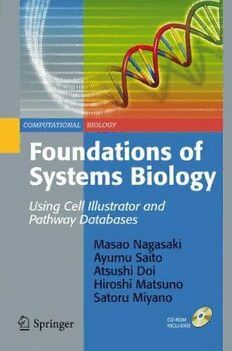
Foundations of Systems Biology: Using Cell Illustrator® and Pathway Databases PDF
166 Pages·2009·11.59 MB·English
Most books are stored in the elastic cloud where traffic is expensive. For this reason, we have a limit on daily download.
Preview Foundations of Systems Biology: Using Cell Illustrator® and Pathway Databases
Description:
Navigating safely through a wealth of genome, protein and metabolite information, as well as a host of information processing tools, without getting lost is crucial for successful research in – and teaching of - molecular biology.This concise, easy-to-follow textbook/guide serves as a valuable introduction to contemporary cell biology for readers and offers insight into the key research directions in the field. It begins with an overview of existing tools for finding, designing and investigating metabolic, genetic, signalling and other network databases. This practical guide then introduces Cell Illustrator®, a software tool for biological pathway modelling and simulation, developed by the authors. In-depth discussion reveals how this tool can be used for creating, analyzing and simulating biological models, thereby explicating and testing current understanding of basic biological processes. Readers do not require prior knowledge of differential equations or programming.Features:• Provides many helpful learning aids, such as detailed examples throughout, and exercises and solutions• Designed and structured to be part of a semester-long course• Discusses the computational functionalities required for Systems Biology• Addresses practical issues surrounding software tools• Introduces the current big bio-databases such as TRANSPATH® by Biobase, and explains why and how they can be used to develop and support systems biology research• Explains important pathway databases and software tools, together with their related concepts• Guides the reader to model pathways in a step-by-step and clear manner• Contains a Foreword written by Professor Andreas Dress, Director CAS-MPG Partner Institute for Computational Biology, Shanghai Institutes for Biological Sciences, Chinese Academy of SciencesWritten for undergraduates, this reader-friendly introduction to the field of Systems Biology offers insight and teaches sound expertise in the subject. It will also prove valuable to graduate students and professionals wishing to develop and support their systems-biology research.
See more
The list of books you might like
Most books are stored in the elastic cloud where traffic is expensive. For this reason, we have a limit on daily download.
